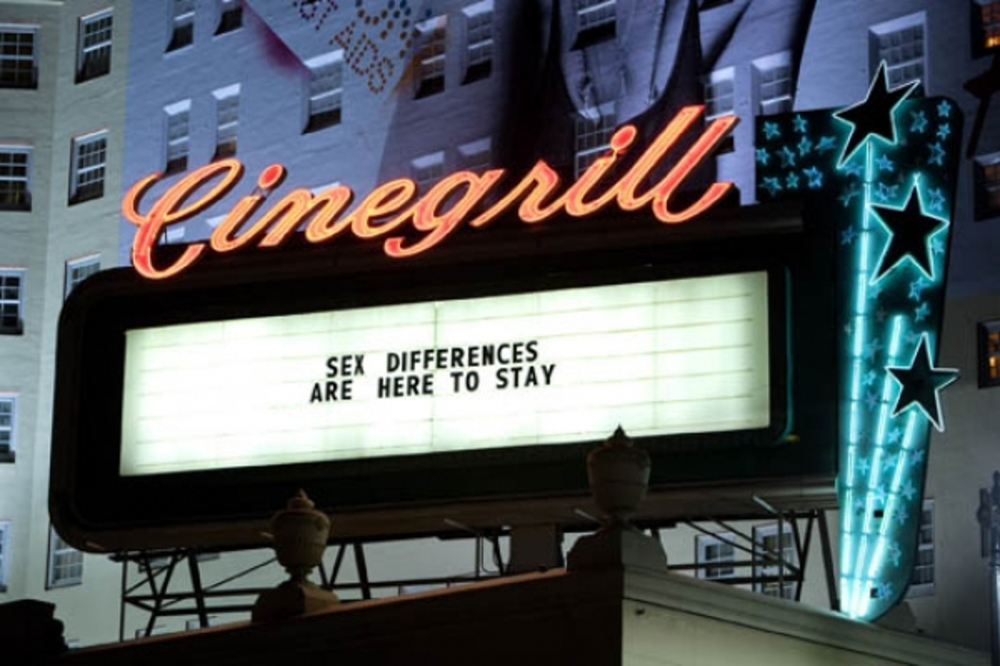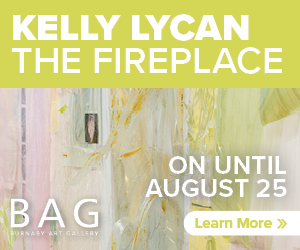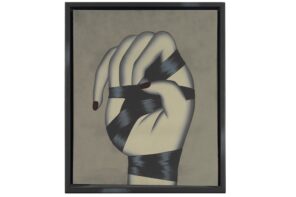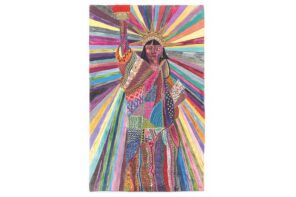Dear Dick, I’m wondering why every act that narrated female lived experience in the ‘70s has been read only as “collaboration” and “feminist.” The Zurich Dadaists worked together too but they were geniuses and they had names.
— Chris Kraus
“SEX DIFFERENCES ARE HERE TO STAY,” flashes one of Jenny Holzer’s pithy Truisms. Projected on the wall of the entranceway to QUEENSIZE — Female Artists from the Olbricht Collection, currently on view at the me Collectors Room in Berlin, Holzer’s influential series functions as a Trojan Horse forging a path through the jargon of corporate slogans. Her messages strike a particularly ironic note at the entrance of this exhibition, which includes works by some of contemporary art’s most celebrated women artists – Louise Bourgeois, Kiki Smith, Marlene Dumas, Rineke Dijkstra, Cindy Scherman, Laurie Simmons, Taryn Simon, Mona Hatoum – among many others. The inherent irony in Holzer’s “truisms” is that she presents them as resolute, despite their fundamental substance often being spiritual or speculative in nature. Are sex differences here to stay? It’s a poignant statement to lead an exhibition dedicated exclusively to art made by women.
I felt ambivalent about visiting QUEENSIZE, suspicious of gendered modes of exhibition making. It’s an ambivalence exemplified by the implicit cautioning of Chris Kraus’s quote above: we lose something when the labor and creative production of women is exiled to the acquiescent boxes of “feminist” and “collaboration.” Yet employing these categories has been a historically essential strategy for women artists wanting a foothold in the perennially patriarchal systems of art (and for that matter, everything else). Linda Nochlin attempted to account for why there had been no great women artists in her eponymous 1971 essay; Miriam Shapiro started the short-lived Feminist Art Program at CalArts in 1972, from which “Womanhouse,” the temporary feminist installation and performance space co-run by Judy Chicago, was born; A.I.R. Gallery, the first women-only artist-run center in the US, was founded in 1972 in New York City; and later that decade, in 1979, a group of women-artists founded the New York Feminist Art Institute. These benchmarks are a few of the many women-only initiatives born in the wake of 1960s second-wave feminist activism.
The legacy of sequestering space for women – both physical and immaterial – has persisted past the 1970s, with its zenith taking form in expansive blockbuster exhibitions such as WACK! Art and the Feminist Revolution (a traveling show that originated at MOCA LA), and Global Feminisms, at the Brooklyn Museum, both initiated in 2007. Closer to home, and more recently, there are many instances of feminist exhibitions in Canada that continue the effort: Allyson Mitchell’s Kill Joy’s Kastle, produced by Toronto’s AGYU, and the recent exhibition Material Girls, at the Dunlop Art Gallery in Regina, which was “about women taking up space [and] an exploration of material process and notions of excess as they relate to the feminized body, gendered space, and capitalist desire.” Further, online exhibitions such as Body Anxiety, curated by Jennifer Chan and Leah Schrager, speak to the increasingly complicated landscape of feminist art praxis in the context of new forms of sexism and violence that have emerged and flourished within the sprawling channels of the internet.
Such women-only institutions and exhibitions promote a critical method of seeking parity in the face of deep-rooted privilege structures. And thanks to the earnest and unflagging labor of the feminists who spearheaded such projects in the 1970s, my generation has enjoyed opportunities and benefits hitherto out of reach. However, exhibitions centered on radical or separated communities bear their own set of strictures. They can propagate particular sets of exclusionary criteria, while also limiting potential readings of the works. Are these initiatives and frameworks still the most critical, cogent, or productive means of balancing the scales of a perpetually off-kilter artworld?
The exclusionary nature of certain feminisms is a well-worn narrative, and a continually pertinent and adapting topic for debate. In the early 1980s, bell hooks pointed to the inefficacy of feminist strategies to dismantle what she terms the white supremacist capitalist patriarchy; her call for a radical restructuring of the system points to the ways in which feminism’s logics were insufficient in their failure to also seek reparations for other inequalities, such as those based on race and class. For hooks these are not mutually exclusive modes of oppression, but, rather, wholly entangled in the same monolithic system. It’s a system in which we’re still firmly entrenched. In a WACK! catalogue essay, scholar Valerie Smith elaborates on the conundrum of being a black woman in the 1960s. By participating in the implicitly sexist Civil Rights Movement, women of color felt pushed to relinquish their pursuit of feminism. Inversely, in feminist activism, black women were expected to shelve their pursuit of fighting racism as it was considered a diversion from the ultimate goals of (white) feminisms. In this context and out of necessity, specifically radical spaces such as “Where We At” Black Women Artists Inc. emerged. This preceded an eruption of curatorial endeavors that bore out innumerable ethnic-specific exhibitions from the 1990s onward.
Do these sequestered “rebel” spaces become more limiting than exposing for the artists involved? When women’s-only institutions mimic the marginalization they aim to undermine, compelling the advent of still more institutions which are specifically aimed at black women, for example (forcing black-women artists to be twice removed from everyone else), is it any wonder that Adrian Piper, in wry exasperation, recently retired from being black? “In the future, for professional utility, you may wish to refer to her as The Artist Formerly Known as African-American,” she stated. It’s a gesture that speaks to the ceiling of being segregated and set apart form the rest of the artworld.
Ghettoization in any form – gender, race, ethnicity, geographic location – that seeks to ratify exclusion, poses a number of problems, chief among them, reductionism. While many of the artists in WACK!, including Martha Rosler, Eleanor Antin, Carolee Schneemann, Mary Beth Edelson, and Judy Chicago, explicitly address various issues related to feminism, others do not. Marina Abramović (contemporary spectacle notwithstanding) has consistently resisted readings of her work as feminist. She maintains that her early radical performances were chiefly about pain and the limits of the body. Yoko Ono’s practice is likewise not uniquely feminist, but situated within the bourgeoning movements of conceptual art, performance, and Fluxus. Pop Art is indebted to Yayoi Kusama. Hannah Wilke was an artist who shared a vexed relationship with feminism in her earlier work, where vaginas and hair rollers abounded; however her late photographs, made at the end of her life that was cut short by cancer, affect a moving, visceral, and sincere exploration of the medical-industrial system, mortality, and the precariousness of being human. In consigning these artists’ work to the silo of “feminisism” by virtue of their inclusion in a women’s-only exhibition, nuance and import are put at risk and often failed. As Georgia O’Keeffe put it, “The men liked to put me down as the best woman painter. I think I’m one of the best painters.”
A similarly homogenizing effect prevails in QUEENSIZE, where the exhibition contextualizes its work by the subjectivities of its artists’ gender or their female subjects, canopied under the curatorial metaphor of the bed as a poetic locale where various aspects of a woman’s life are experienced (birth, sex, life, and death). Kiki Smith’s Bloodline, which boldly snakes through the exhibition, is used as a sort of leitmotif that threads the variously-themed rooms (girlhood innocence, a woman’s life, women’s death). Yet Smith’s oeuvre is about so much more: the human body, its excretions, and the rupture that occurs when the boundaries between the internal and the external are dissolved. Some of her work’s jarring abjection is lost when framed within the “female bloodline.”
Similar arguments could be made for many of the near-100 critically-lauded pieces in this exhibition. Gender is always a critical component of subjectivity, of course, but when the practices of these leading women artists are reduced to their woman-ness (or their relationship to it), we slide backwards in our advancement to equality – a goal sometimes critiqued for having a myopic endgame (why seek parity within a system that creates the conditions of oppression?). Parity likewise assumes a common subjectivity among all women, a contentious notion.
Gender is burning hotter than ever, the incendiary alcoves of the internet adding height to the fire. It’s apparent and complex, a conversation featuring celebrations and controversies regarding gender identity and sexual orientation that complicates discreet binaries. With the popular example of Caitlyn Jenner recently gracing the cover of Vanity Fair, we should remember that while the mainstream media initially embraced Jenner’s transition, critiques of her conceptualization of self-as-woman quickly followed. Elinor Burkett published a lengthy opinion piece in the New York Times that was wildly divisive: many women rallied with her, echoing her argument that, “People who haven’t lived their whole lives as women shouldn’t get to define us. That’s something men have been doing for much too long … They haven’t traveled through the world as women and been shaped by all that this entails.” Others were rightly enraged by the anti-trans sentiment that threaded its text, arguing that the Times undermined transgender rights. Hadley Freeman succinctly summarizes Burkett’s failings in The Guardian, writing that, “Second-wave feminists, of which Burkett is one, remember clearly the fights they led to liberate women from horrible constraints, and they did this so successfully that few women born after 1980 can imagine living under such constraints today. But at no point did Western women endure the kind of marginalization and risk of violence and suicide still suffered by so many trans people today.”
The artworld is no stranger to this clash of differing radical communities. Even projects that are hypersensitive to contemporary issues of violence and marginalization can be guilty of alienating others. Such was the case with the curators of the aforementioned Body Anxiety exhibition. While their project was critical and timely, the curators freely admit that there was an “inadequate presence of women of color and of queer and trans artists” within the online exhibition. Similarly, Allyson Mitchell’s Kill Joy’s Kastle sparked a heated debate in Toronto, much of which focused on issues of white exclusivity and insensitivity to trans people. QUEENSIZE, by virtue of being curated from a private collection, speaks to how the art market and collecting practices also carry their own set of exclusionary tendencies as 87% of the artists included in the exhibition hail from Europe and the US. Likewise, many of the other exhibitions mentioned here neglect to include a consideration of woman-ness that is broad and inclusive of marginalized factions of gender.
Inequality abounds. In his essay “White Walls, Glass Ceiling” (published in his 2013 book, 9.5 Theses on Art and Class), critic Ben Davis describes the stagnation and continued gender disparity in the arts and in greater social and economic contexts as the “strange and disorienting postfeminist quagmire of the new millennium.” Maura Reilly, who co-curated Global Feminisms, outlined statistics that indisputably speak to the artworld’s staggering gaps between men and women in a recent article for ARTnews. She calls for more women-only exhibitions to combat these tired numbers (this tired reality). I’m not sure I agree. If the plight for women’s equality precludes equality for others, while simultaneously evacuating wider contextual interpretations of our endeavors, then it’s time we abandon these initiatives. And if, as Holzer proclaims, sex differences (or, any differences) are here to stay, we should pursue new configurations to co-exist as different, ones that undermine the systems that leverage difference as a means to marginalize. Sequestered spaces have become a consolation prize; we shouldn’t settle for queen-sized anymore. It’s always one lesser than a king.















Of interest is the gender shift of changing times. While I haven’t really counted numbers, it seems that many of the Canadian art administrators and curators I meet are women. Has the feminist statement altered gender representation in curatorial and arts administration? Will this have a positive effect in the representation of CND women artists… or globally?